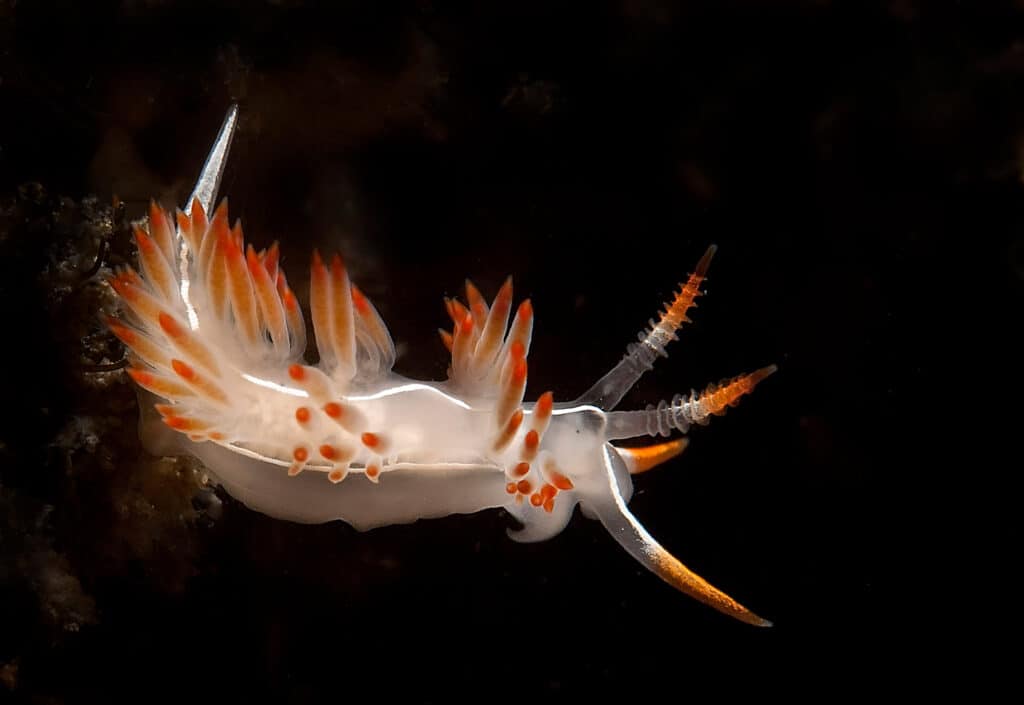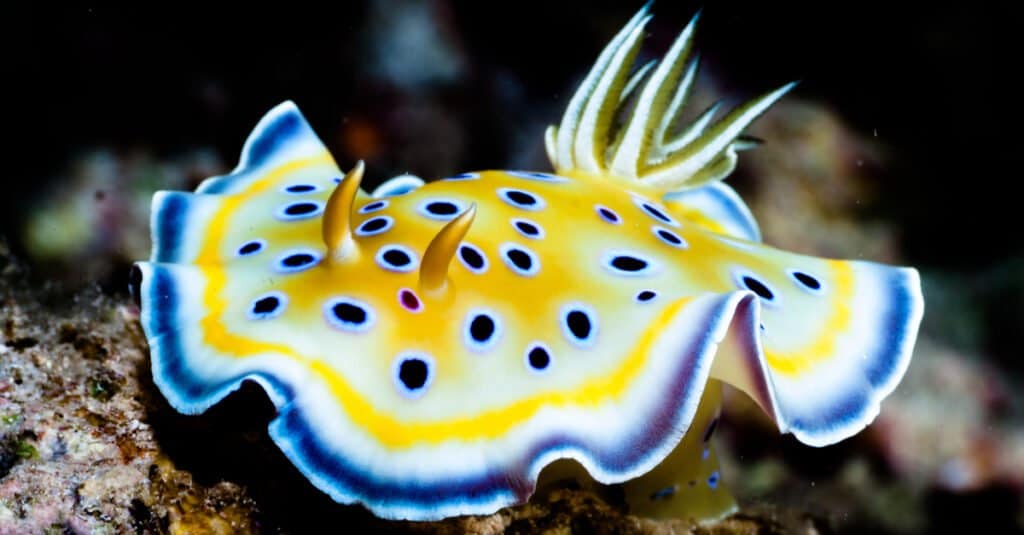Sea slugs are invertebrate tiny marine animals known for their bright colors and intricate body patterns. These tiny creatures live in seas all over the world at varying depths. Additionally, all sea slugs comprise both male and female organs. Finally, these animals do not have shells but have gills and horns on their bodies. They are also called gastropods, mollusks, and pteropods.
Nudibranch is very similar to sea slugs as they are brightly colored invertebrates and get toxins from their prey to use against predators. Nudibranchs also belong to the gastropod family and are hermaphroditic. They come in striking colors such as blue, yellow, green, purple, pink, and red, but let’s discover what else separates the sea slug vs. nudibranch.
Comparing Sea Slug vs. Nudibranch

There are more than 3,000 nudibranch species.
©kaschibo/Shutterstock.com
| Sea Slug | Nudibranch | |
|---|---|---|
| Scientific Name | Nudibranchia | Nudibranchia |
| Length | 1/8 – 12 inches | 0.25 – 1.5 feet |
| Legs | None | None |
| Diet | Plankton, algae, jellyfish (omnivore) | Sea slugs, other nudibranchs, coral, anemones, sponges (Carnivore) |
| Lifespan | 1 – 4 years | 1 – 4 years |
| Eggs Produced | 1,000,000 | 1,000,000 – 25,000,000 |
| Number of Species | 2,000 | 3,000 |
| Predators | Fish, crabs, lobsters, humans | Other nudibranchs, turtles, crabs, humans |
Key Differences Between Sea Slugs and Nudibranchs
The key differences between sea slugs and nudibranchs are size, behavior, where they are found, diet, reproduction, defense mechanism, and predators.
Sea Slugs vs. Nudibranchs: Size

Nudibranches can grow up to lengths from half an inch to 18 inches, depending on the species.
©gary powell/Shutterstock.com
Depending on the species, sea slugs are anything from 1/8 inch to 12 inches long. Nudibranches can grow up to lengths from half an inch to 18 inches, depending on the species.
Sea Slugs vs. Nudibranchs: Behavior
Sea slugs have enormous variations in body shape, size, and color. The reef-dwelling slugs are often brightly colored to warn predators of their toxic stinging cells. Additionally, sea slugs do have brains with approximately 20,000 nerve cells. Another fascinating fact is that the lettuce slug uses a process known as kleptoplasty to absorb chloroplasts from algae. It consumes algae specifically to photosynthesize its sugars. The ruffles on the slug’s body allow it to increase its surface area to absorb more light.
The nudibranch is a benthic animal that spends time crawling over the substrate at the bottom of the waters it inhabits. Some species float upside down just below the ocean water’s surface. Also, their eyes are simple organs and can distinguish between light and dark. And their name stems from the Latin word nudus and Greek branchia, which means naked gills. They have smooth skin and travel around exceptionally slowly. Some of these species get their energy from absorbing chloroplasts from algae in a photosynthesis process; the same process sea slugs use to absorb nutrition.
Another curious species is the sea bunny which is a soft body, shell-less type of slug. A Japanese zoologist first discovered them in the 1930s. This species was made famous for its cute resemblance to a rabbit, measuring less than an inch long. They live in coastal waters between the Indian Ocean and Central Pacific.
Sea Slug vs. Nudibranch: Where Are They Found?

Nudibranchs are carnivores that eat sea slugs, other nudibranchs, coral, anemones, and sponges.
©Istvan Kovacs/Shutterstock.com
Sea slugs live in shallow and deep areas of oceans and seas all over the world except for the colder regions. They are prevalent along the eastern and western coasts of North and South America, and the cute sea bunnies occupy areas between the Central Pacific and the Indian Ocean.
Nudibranchs are found in warm and temperate waters all around the world, from the Mediterranean, Atlantic Ocean, Caribbean, Pacific Ocean, and Alaska to Baja, California. They live in salt and brackish water at depths of 30 to 6,500 feet below the surface. Some examples of the 3,000 species are the sea bunny, blue dragon, anemone, Berghia, opalescent sea slug, hooded nudibranch, and phyllodesmium.
Nudibranch vs. Sea Slug: Diet

The sea slugs also have male and female organs but release eggs after mating.
©Daniel Lamborn/Shutterstock.com
Nudibranchs are carnivores and feed on sea slugs, their eggs, barnacles, anemones, sea sponges, and aiptasia. Other favorite foods include the Portuguese Man O’ War, sea butterflies, and other small creatures, depending on their species. Some of these species steal the nematocysts, stinging cells, from their prey, store them in their skin, and release defensive toxic mucous against their predators.
Sea slugs eat plankton, algae, and jellyfish. The blue dragon species are carnivorous and prey on Man O’ War jellyfish.
Nudibranch vs. Sea Slug: Reproduction
Nudibranchs are hermaphroditic, having both male and female organs, but they cannot fertilize themselves. Instead, mating involves a dance-like courtship that lasts a few minutes. They lay their eggs in a gelatinous spiral-like formation, with the number of eggs ranging from one or two up to 25 million. These eggs also contain toxins from their diet, which deter predators. Their lifespan varies from a few weeks to a year, depending on the species. An interesting fact about these hermaphroditic animals is that every parent is always the mother but the father of someone else’s eggs.
The sea slugs also have male and female organs but release eggs after mating. They lay egg masses that can contain up to one million eggs. The blue dragon species lay their eggs on the carcasses of their prey, and other species lay their eggs on vegetation and floating logs. The sea slug’s lifespan ranges from one to four years, depending on the species, and their sexual maturity depends on each species’ lifespan. Incubation of the eggs ranges from five to 50 days, again dependent on the species.
Nudibranch vs. Sea Slug: Defense Mechanism

Sea slugs are omnivores that eat plankton, algae, and jellyfish.
©cbpix/Shutterstock.com
Nudibranch and sea slugs do not have claws or teeth and use toxins to defend themselves and subdue their prey.
Nudibranch vs. Sea Slug: Predators
The nudibranch is preyed on by similar predators to the sea slug. However, they are generally left alone due to the toxic content in their skin.
Sea slugs will eat poisonous prey, but instead of killing them, they store the poison and use it as protection against predators. Slugs will eat each other if small enough, and they are also the targets of fish, crabs, and lobsters. However, because of their toxic skins, predators typically avoid them.
The photo featured at the top of this post is ©
Thank you for reading! Have some feedback for us? Contact the AZ Animals editorial team.






